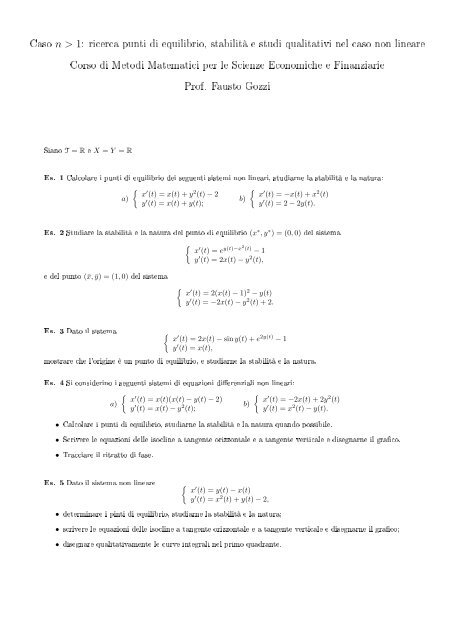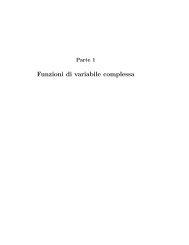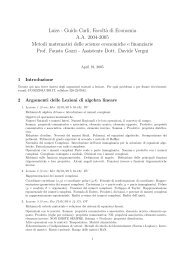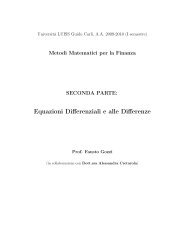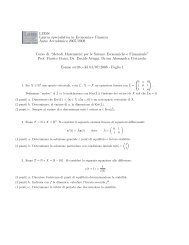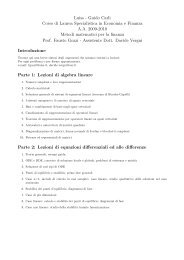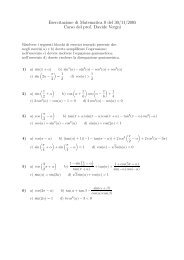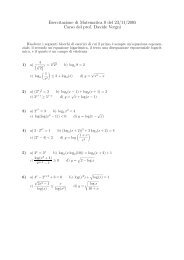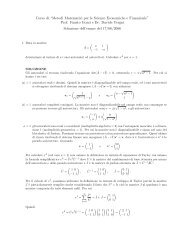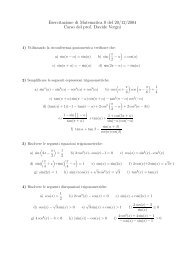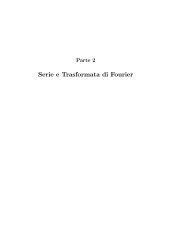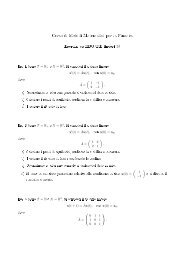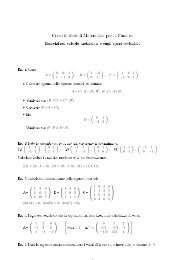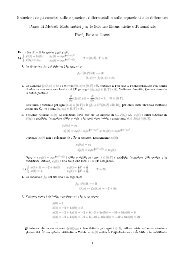Caso n > 1: ricerca punti di equilibrio, stabilità e studi qualitativi nel ...
Caso n > 1: ricerca punti di equilibrio, stabilità e studi qualitativi nel ...
Caso n > 1: ricerca punti di equilibrio, stabilità e studi qualitativi nel ...
You also want an ePaper? Increase the reach of your titles
YUMPU automatically turns print PDFs into web optimized ePapers that Google loves.
<strong>Caso</strong> n > 1: <strong>ricerca</strong> <strong>punti</strong> <strong>di</strong> <strong>equilibrio</strong>, stabilità e stu<strong>di</strong> <strong>qualitativi</strong> <strong>nel</strong> caso non lineare<br />
Corso <strong>di</strong> Meto<strong>di</strong> Matematici per le Scienze Economiche e Finanziarie<br />
Prof. Fausto Gozzi<br />
Siano T = R e X = Y = R<br />
Es. 1 Calcolare i <strong>punti</strong> <strong>di</strong> <strong>equilibrio</strong> dei seguenti sistemi non lineari, stu<strong>di</strong>arne la stabilità e la natura:<br />
a)<br />
{ x ′ (t) = x(t) + y 2 (t) − 2<br />
y ′ (t) = x(t) + y(t);<br />
b)<br />
{ x ′ (t) = −x(t) + x 2 (t)<br />
y ′ (t) = 2 − 2y(t).<br />
Es. 2 Stu<strong>di</strong>are la stabilità e la natura del punto <strong>di</strong> <strong>equilibrio</strong> (x ∗ , y ∗ ) = (0, 0) del sistema<br />
e del punto (¯x, ȳ) = (1, 0) del sistema<br />
{<br />
x ′ (t) = e y(t)−x2 (t) − 1<br />
y ′ (t) = 2x(t) − y 2 (t),<br />
{ x ′ (t) = 2(x(t) − 1) 2 − y(t)<br />
y ′ (t) = −2x(t) − y 2 (t) + 2.<br />
Es. 3 Dato il sistema {<br />
x ′ (t) = 2x(t) − sin y(t) + e 2y(t) − 1<br />
y ′ (t) = x(t),<br />
mostrare che l'origine è un punto <strong>di</strong> <strong>equilibrio</strong>, e stu<strong>di</strong>arne la stabilità e la natura.<br />
Es. 4 Si considerino i seguenti sistemi <strong>di</strong> equazioni <strong>di</strong>erenziali non lineari:<br />
a)<br />
{ x ′ (t) = x(t)(x(t) − y(t) − 2)<br />
y ′ (t) = x(t) − y 2 (t);<br />
b)<br />
{ x ′ (t) = −2x(t) + 2y 2 (t)<br />
y ′ (t) = x 2 (t) − y(t).<br />
• Calcolare i <strong>punti</strong> <strong>di</strong> <strong>equilibrio</strong>, stu<strong>di</strong>arne la stabilità e la natura quando possibile.<br />
• Scrivere le equazioni delle isocline a tangente orizzontale e a tangente verticale e <strong>di</strong>segnarne il graco.<br />
• Tracciare il ritratto <strong>di</strong> fase.<br />
Es. 5 Dato il sistema non lineare<br />
{ x ′ (t) = y(t) − x(t)<br />
y ′ (t) = x 2 (t) + y(t) − 2,<br />
• determinare i pinti <strong>di</strong> <strong>equilibrio</strong>, stu<strong>di</strong>arne la stabilità e la natura;<br />
• scrivere le equazioni delle isocline a tangente orizzontale e a tangente verticale e <strong>di</strong>segnarne il graco;<br />
• <strong>di</strong>segnare qualitativamente le curve integrali <strong>nel</strong> primo quadrante.
Siano T = N e X = Y = R + .<br />
Es. 6 (Modello <strong>di</strong> Lotka-Volterra <strong>di</strong>screto). Si consideri la seguente versione <strong>di</strong>screta del modello preda-predatore<br />
{ x(t + 1) = (1 + a)x(t) − x(t)y(t) − x 2 (t)<br />
y ′ (t) = 1 2y(t) + x(t)y(t),<br />
dove x(t), y(t) rappresentano il numero <strong>di</strong> prede e predatori al tempo t e a ∈ R + .<br />
• Determinare i <strong>punti</strong> <strong>di</strong> <strong>equilibrio</strong> e stu<strong>di</strong>arne la stabilità <strong>nel</strong> caso a = 1.<br />
• Determinare i <strong>punti</strong> <strong>di</strong> <strong>equilibrio</strong> al variare <strong>di</strong> a ∈ R + e stabilire per quali valori <strong>di</strong> a si ha stabilità<br />
asintotica.


